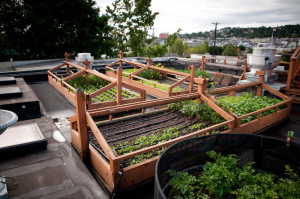by MELISSA PETERMAN, Eater Seattle, July 11, 2013

Photo: Geoffrey Smith/LookatLao Studio
Source: www.seattle.eater.com
Welcome back to Up on the Rooftop, a monthly column by Seattle Slow Food board member and writer Melissa Peterman, who gets up close and personal with Seattle’s mile-high club in the form of (mostly) rooftop gardens.
With the incredible spring weather we had, and what’s shaping up to be a summer to match, diners can expect to see more rooftop garden produce taking center stage on Seattle menus. This month, we talk to Jason Stoneburner about how things have been progressing with his rooftop garden at Bastille and what he’s most excited about this summer (like, those awesome rooftop dinners). It should be noted that at the time of this interview, Stoneburner had not yet opened, but chef Jason says that he is definitely sharing produce from Bastille’s rooftop garden with his namesake restaurant, especially when it’s in full-swing like it is right now.
What’s in season right now from your garden that you have featured on the menu?
Turnips, radish, freckled lettuce, pea vines, parsley, bay loral, pepper cress, mustard greens and little gem lettuce are all in circulation.
What have you planted this year that you are particularly excited about or looking forward to?
I really get excited about it all! If I have to pick I would say haricot vert — it really marks the pinnacle of summer. This small tender french varietal of green bean fetches top dollar at farmers markets and I find it rewarding to pluck them from the vine. Pepper cress and frilly mustard greens are among my favorites for their fiery flavor profile.
Do you change things up, in regards to planting every year, or do you look to plant new things all the time?
Our staples are various heirloom varieties of radish, carrots, turnips and arugula. These staples grow apace and are easy to cultivate. We do experiment with lesser known greens, veggies and flowers such as spilanthes, shunkyo radish, curry plant, ice plant, anise hyssop and winter density romaine. Just to name a few.
Was there always a plan for having a culinary garden when the restaurant was being built? How many years have you had this garden now?
It took a lot planning from the beginning to implement the rooftop garden. The restaurant had to be structurally engineered to support the weight of nearly 18 tons of soil. Everything from the logistics of building the raised beds to rain sensors were thought out prior to opening. It was such an exciting prospect to see a garden being constructed at the same time as the kitchen and now is a vibrant provence of the restaurant.
How much of your produce comes from your garden?
In full-swing we calculated that 12-15% of produce is being harvested from the roof. The menu is peppered with ingredients from the roof, and often our plats du jour are 100% rooftop garden-based.
Any surprises in regards to yields, what grows best?
Mizuna seems to be an over-achiever almost all year around.
How you have been able to use the garden in other ways besides menu items?
We have involved ourselves in an education series that focus on youth. Just recently we had Bothell High School culinary arts students on a day field trip which involved a presentation of hands on garden work, in depth walk through and Q&A. Afterwards the students enjoyed a rooftop garden inspired lunch and a presentation on locally foraged wild products (wild products provided by foraged and found edibles). Our bar manager Eric Carlson also utilizes the garden for his cocktail menus.
What are some of the best things about having a garden so close to your kitchen?
It’s a great way to switch gears and break up the day. Our kitchen is fast paced and it’s therapeutic to put the knife down and get your hands dirty. The spark of creativity that is delivered from a quick stroll through the garden is rich.
Who currently manages the garden?
Colin McCrate and Brad Halm (Seattle Urban Farm) help us populate and mend the soil. I and the Bastille kitchen staff thin and harvest.
Goals for the garden’s future?
Growth! Keeping thing interesting and continue to include the community of our “growings” on.